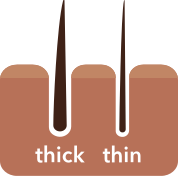How it works
Hair follicles come in different shapes and sizes, affecting hair texture and width. Some people have wider follicles-and therefore, thicker hair strands-than other people. Genetics influence hair thickness, but other factors like hormones and age are important factors, too.
The genetic link
Scientists think many genes contribute to hair thickness. Research indicates that the EDAR gene, which influences hair follicle development, plays an important role in determining hair thickness.

Did you know?
If you’re of East Asian descent, you probably have thicker strands of hair than your friends of African or European descent.
Explore more
Curious to see what your genes have to say about your strands? 23andMe’s Health + Ancestry Service can give you a closer look. Order a kit and find out whether your DNA predicts you’re likely to have thick or thin hair.

Health + Ancestry Service
References
23andMe Blog (2018, October 5). “23andMe Adds Four New Trait Reports.” Retrieved October 31, 2018, from “https://blog.23andme.com/health-traits/23andme-adds-four-new-trait-reports/”.

Leave a Reply